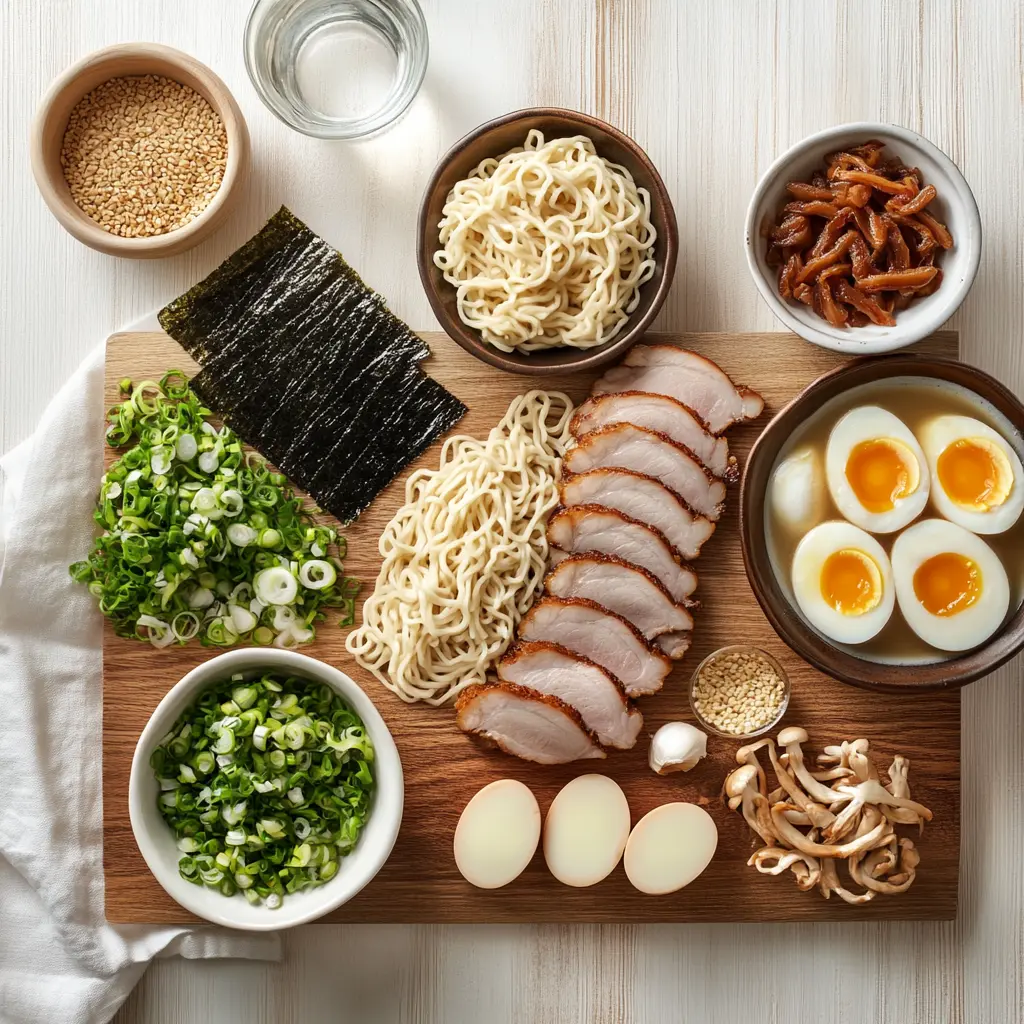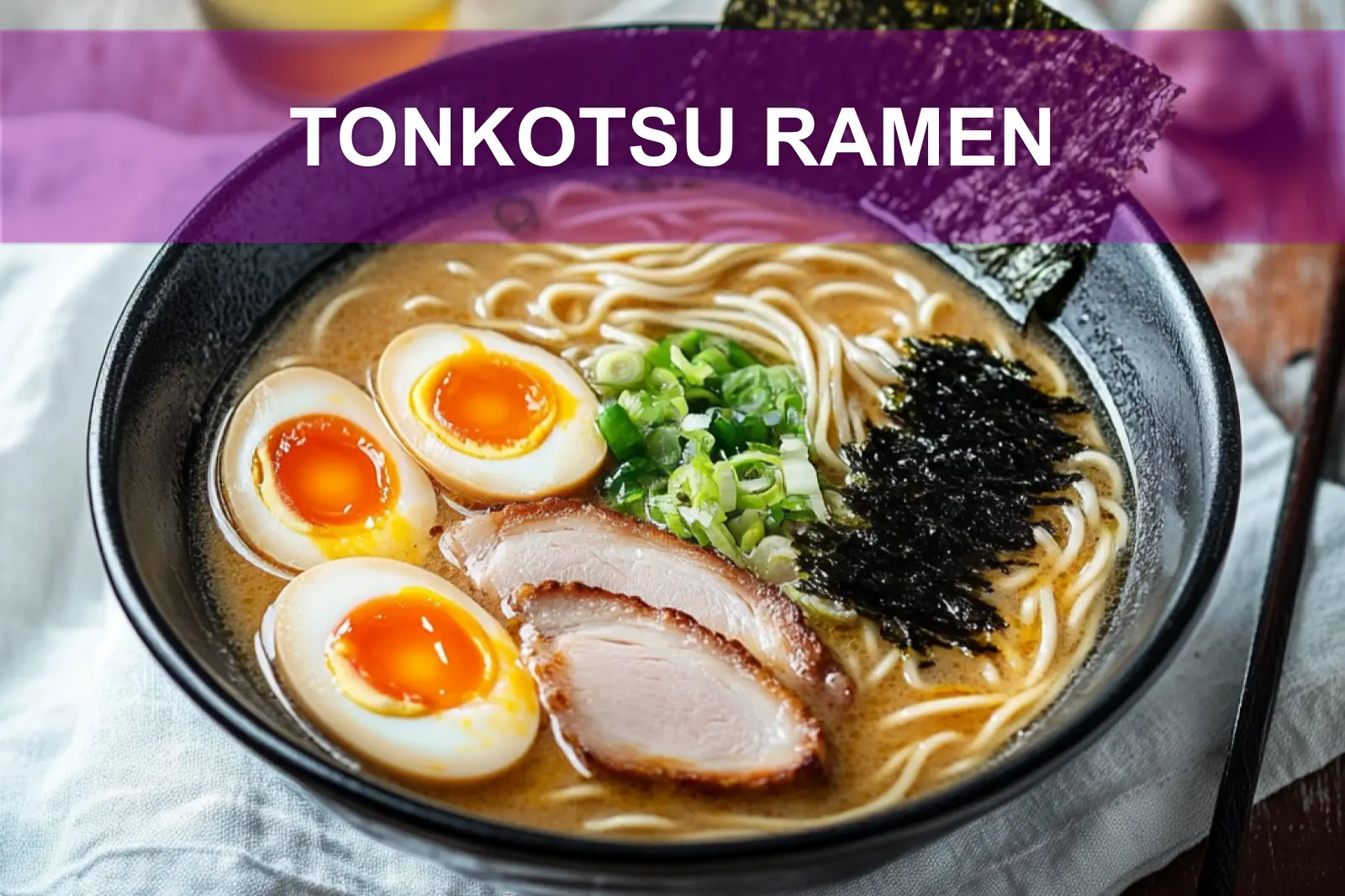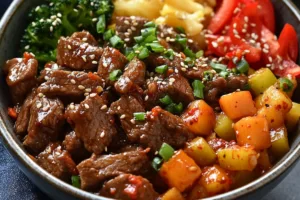The first time I had tonkotsu ramen, I slurped it too hot, burned my tongue, and fell in love anyway. Creamy, fatty, soul-hugging broth? YES PLEASE. Now it’s all over social feeds with that dreamy Korean ramen aesthetic and moody ramen photography vibes.
This one’s rich, savory, and secretly simple. A few pantry darlingspork bones, soy sauce, scallionsand boom, you’re on a noodle cloud. It’s got that spicy ramen aesthetic, but zero snobbery. Cozy like chicken soup, but with way more slurp. Full details in the blog!
We’ve tested this ramen more times than I can count (my sink still smells like garlicsorry, neighbors). Pulled from family comfort food memories and a chaotic week of trial-and-error, this one’s finally ready. I added something unexpected. I tested it. You’ll love the secret!
Why You’ll Love This Tonkotsu Ramen
If you love cozy, slurpable comfort food that hugs your soul, this Tonkotsu Ramen is your dream come true. Here’s why you’ll want to grab a cute ramen bowl and dive in:
- Rich and creamy broth: This collagen-packed broth is slow-simmered to perfection, giving you that luxurious, velvety texture iconic to Japanese ramen aesthetics.
- Beginner-friendly: While the cook time is long, the steps are simple and totally doable. It’s more about patience than perfection!
- Customizable: Create your own ramen noodles aesthetic with toppings like soft-boiled eggs, nori, and chashu porkyou’ve got options!
- Nostalgia in every slurp: Whether it’s your first ramen-making adventure or a nod to Japanese ramen vibes, this is all about bringing that cozy, homemade magic.
Key Ingredients & Tools You Need
You don’t need a chef’s kitchen for this, but a few essentials will set you up for success. Here’s what you’ll need:

- The Broth Base: Pork trotters, pork bones, dried shiitake mushrooms, and aromatics (garlic, ginger, onion, leeks). This is your golden ticket.
- Noodles: Use good-quality ramen noodles that will stand up to that glorious broth.
- Toppings: Chashu pork, boiled eggs, roasted nori, menma (optional), and chopped negi (spring onions).
- Tools You’ll Want: A large stockpot, fine sieve, and a hand blender for puréeing the tender pork skin. Don’t have a hand blender? A food processor works too!
Pro Tip: A heavy pot with a lid will help keep the broth from evaporating too quickly during the long simmer.
| Ingredient | Purpose |
|---|---|
| Pork Trotters & Bones | Create the rich, collagen-packed broth base |
| Dried Shiitake Mushrooms | Add an earthy depth and umami to the broth |
| Ramen Noodles | The chewy vehicle for all that delicious broth |
| Chashu Pork | Classic tender topping for the Japanese ramen aesthetic |
Step-By-Step Guide to Homemade Tonkotsu Ramen
This is a low-stress, high-reward project. Just follow these steps, and you’ll have ramen that tastes like it belongs in a spicy ramen aesthetic photo shoot.
- Prepare the bones: Boil the pork trotters and bones briefly, then rinse to remove impurities. This step ensures a clean, clear broth.
- Sauté the aromatics: In a large, clean pot, heat oil and sauté garlic, ginger, and onions until fragrant.
- Simmer the broth: Add the sautéed aromatics, cleaned bones, leeks, mushrooms, and enough water to cover. Simmer for 4 hours, checking water levels as needed.
- Strain and purée: Strain the broth, reserving the bones. Scrape off tender fat and pork skin, purée until smooth, and return it to the pot for extra creaminess.
- Final simmer: Keep simmering the broth for 2 more hours, seasoning with salt to taste. While the broth finishes, cook your ramen noodles.
- Assemble your bowls: Add cooked noodles to your bowl first, then ladle over the creamy broth. Top with chashu pork, a soft-boiled egg, nori, and spring onions.
| Step | Timing |
|---|---|
| Bone Prep | 20 minutes |
| Initial Simmer | 4 hours |
| Final Simmer | 2 hours |
| Ramen Assembly | 10 minutes |
Troubleshooting & Tweaks
Even cozy meals can get chaotic! Here’s how to troubleshoot common issues and tweak your ramen experience:
- No froth? Make sure the broth simmers gentlytoo much heat can break down that milky consistency.
- Too salty? Add a small amount of hot water or unsalted broth to balance the flavors.
- Short on toppings? Swap boiled egg with a soft-yolked poached egg, or add extra spring onions for a veg ramen bowl vibe.
- Allergic to pork? Try a chicken-based bone broth instead (though it won’t quite hit the Japanese ramen aesthetic).
| Common Problem | Solution |
|---|---|
| Broth is too bland | Season with soy sauce or a pinch of salt |
| Milkiness missing | Ensure the fat and pork skin purée is blended thoroughly |
| Broth evaporated too much | Add more water and simmer gently |
Serving & Storage
The beauty of this ramen is how easily it adapts to your schedule. Here’s how to serve and store it like a pro:
- Serving: Ladle the hot broth over fresh ramen noodles right before serving so the noodles keep their bite.
- Storage: Refrigerate leftover broth in an airtight container for up to 4 days, or freeze for up to 3 months.
- Noodle Tip: Cook noodles fresh for each servingleftover noodles in broth can get soggy.
| Storage Method | How Long |
|---|---|
| Refrigerator | Up to 4 days |
| Freezer | Up to 3 months |
| Cooked Noodles | Best served fresh |
Expert Insight: Mastering the Depth of Tonkotsu Ramen
Tonkotsu ramen is renowned for its rich, creamy broth, achieved by simmering pork bones for hours to extract deep umami flavors. Achieving the perfect balance between broth richness and noodle texture is key to an authentic experience, making patience and technique essential in this beloved Japanese dish.
For more delicious recipes and cooking inspiration, follow me on Facebook, Pinterest and Reddit!
Finally Nailing My Tonkotsu Ramen
After what felt like countless pots simmering away and a few broth disasters, I finally cracked the code for my Tonkotsu Ramen. It took several evenings of adjusting flavors and slow-cooking, but now the rich, creamy broth tastes like a warm hug from my family’s kitchen.
FAQs ( Tonkotsu Ramen )
What makes tonkotsu ramen different from other ramen types?
Tonkotsu ramen is distinguished by its rich, creamy pork bone broth that’s simmered for 12-24 hours until it becomes milky white. This Japanese ramen aesthetic creates a deeply flavorful, collagen-rich base that’s much thicker and more indulgent than clear broths like shoyu or shio. The long cooking process extracts maximum flavor and nutrients from pork bones, resulting in a truly authentic and satisfying bowl of ramen.
How long does it take to make authentic tonkotsu ramen broth?
Authentic tonkotsu ramen broth requires 12 to 24 hours of continuous simmering to achieve its signature creamy texture and deep flavor. The pork bones need to be boiled at a rolling boil to properly emulsify the fats and collagen. While this might seem intimidating, most of the time is hands-off cooking, and the incredible results are absolutely worth the patience!
Can I make tonkotsu ramen in a pressure cooker or Instant Pot?
Yes, you can make a delicious tonkotsu-style broth in a pressure cooker in about 2-3 hours instead of 24 hours on the stovetop. While it won’t be exactly identical to the traditional method, pressure cooking effectively extracts collagen and creates a rich, creamy broth. This modern approach is perfect for home cooks who want to enjoy authentic flavors without the time commitment, and it still looks beautiful in a cute ramen bowl.
What are the essential toppings for tonkotsu ramen?
Traditional tonkotsu ramen is topped with chashu (braised pork belly), soft-boiled ajitsuke eggs, chopped scallions, bamboo shoots, and nori seaweed. Many bowls also include black garlic oil, corn, and bean sprouts for extra flavor and texture. The key is balancing these toppings to complement the rich broth without overwhelming it, creating a visually appealing presentation perfect for ramen photography.
Where can I buy pork bones for tonkotsu ramen in the USA?
You can find pork bones for tonkotsu ramen at Asian grocery stores, local butcher shops, or by requesting them from your neighborhood grocery store’s meat department. Many butchers will order pork trotters, neck bones, and back bones if given advance notice. Online retailers and specialty meat suppliers also ship high-quality pork bones nationwide, making it easier than ever to create restaurant-quality tonkotsu ramen at home.

Wrapping Up Your Tonkotsu Ramen Adventure
Tonkotsu ramen comes together with love, patience, and just the right creamy, rich broth you’ll wanna dive into again and again. It may take a while, but this cozy, soul-hugging noodle feast is 100% worth ityour kitchen will smell like a ramen shop, promise!
Feel free to switch up toppings for a spicy ramen aesthetic or even a veg ramen bowl vibe. Leftovers? Freeze that broth or reheat gently for another quick slurp. A little kitchen magic and some ramen bowl design love go a long waytrust me, I’ve burned my tongue for this!
Now it’s your turn: snap your cutest ramen bowl pics, share your tweaks, or just tell medid ramen ever steal your heart too? Pass this cozy bowl on and bring a little ramen warmth to your table. You’re gonna love the homemade charm in every slurp!
Print
TONKOTSU RAMEN
- Total Time: 6 hours 20 minutes
- Yield: 5–6 servings 1x
Description
Tonkotsu ramen is a rich and collagen-packed Japanese noodle dish featuring a creamy pork broth that simmers for hours. Perfect for ramen photography enthusiasts, this recipe delivers the authentic korean ramen aesthetic and spicy ramen aesthetic with every bowl.
Ingredients
- 5 to 6 servings Good quality ramen noodles (you don’t want to ruin that 6 hour broth with a crappy noodle)
- Chashu pork (recipe here)
- 5 to 6 pcs Boiled eggs
- Negi (spring onions) chopped
- Menma (fermented bamboo shoots) optional
- Roasted Nori squares
- 1 1/2 kg pork trotter
- 1 kg pork bones
- 1 large onion roughly chopped
- 1 whole garlic minced
- thumb sized ginger sliced thinly
- 2 pcs leeks roughly chopped
- 6 pcs dried shiitake mushrooms
- oil
- salt
Instructions
- In a large stock pot add pork trotters and pork bones then fill it with water enough to cover everything. Bring it to a boil and continue to boil until the scum appears on top. Turn the heat off then drain.
- Clean the pork bones and trotters in running water removing any scum that is stuck on it.
- In clean stock pot add oil then sauté onion, garlic and ginger.
- Add the pork trotters, bones, leeks, dried shiitake mushrooms and salt. Fill it again with water enough to cover everything roughly 4 to 5 litres, cover with heavy a lid then bring it to a boil. Once boiling reduce to simmering heat and simmer for 4 hours, check water levels making sure it does not dry out adding water if necessary.
- After 4 hours, turn the heat off then strain the liquid using a fine sieve into a separate pot, reserve the bones. At this point you need to have at least 3 litres of stock if not add water. Place pot on stove top then bring it to a boil, once boiling lower to simmering heat.
- Scrape off the very tender fat and skin from the trotter bones until you have around 1 1/2 cups of tender pork skin. Place them in a bowl then using a hand blender puree them until smooth in consistency, pour this into the simmering soup.
- Continue to simmer the broth for 2 more hours, season with salt then turn heat off.
- Cook ramen noodles according to packet instructions.
- Place ramen noodles in a bowl then pour the pork broth, top with thinly sliced Chashu pork, Boiled eggs, chopped spring onions, nori and menma.
- Prep Time: 20 minutes
- Cook Time: 6 hours
- Category: Main Course
- Method: Boiling and Simmering
- Cuisine: Japanese
Nutrition
- Serving Size: 1 bowl
- Calories: 600 kcal
- Sugar: 3g
- Sodium: 1200mg
- Fat: 40g
- Saturated Fat: 15g
- Unsaturated Fat: 20g
- Trans Fat: 0g
- Carbohydrates: 45g
- Fiber: 5g
- Protein: 35g
- Cholesterol: 100mg












